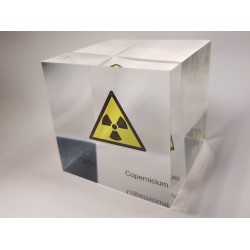- Shop
- Acrylic cubes
-
Elements
- Hydrogen
- Helium
- Lithium
- Beryllium
- Boron
- Carbon
- Nitrogen
- Oxygen
- Fluorine
- Neon
- Sodium
- Magnesium
- Aluminium
- Silicon
- Phosphorus
- Sulfur
- Chlorine
- Argon
- Potassium
- Calcium
- Scandium
- Titanium
- Vanadium
- Chromium
- Manganese
- Iron
- Cobalt
- Nickel
- Copper
- Zinc
- Gallium
- Germanium
- Arsenic
- Selenium
- Bromine
- Krypton
- Rubidium
- Strontium
- Yttrium
- Zirconium
- Niobium
- Molybdenum
- Technetium
- Ruthenium
- Rhodium
- Palladium
- Silver
- Cadmium
- Indium
- Tin
- Antimony
- Tellurium
- Iodine
- Xenon
- Cesium
- Barium
- Lanthanum
- Cerium
- Praseodymium
- Neodymium
- Promethium
- Samarium
- Europium
- Gadolinium
- Terbium
- Dysprosium
- Holmium
- Erbium
- Thulium
- Ytterbium
- Lutetium
- Hafnium
- Tantalum
- Tungsten
- Rhenium
- Osmium
- Iridium
- Platinum
- Gold
- Mercury
- Thallium
- Lead
- Bismuth
- Polonium
- Astatine
- Radon
- Francium
- Radium
- Actinium
- Thorium
- Protactinium
- Uranium
- Neptunium
- Plutonium
- Americium
- Curium
- Berkelium
- Californium
- Einsteinium
- Fermium
- Mendelewium
- Nobelium
- Lawrencium
- Rutherfordium
- Dubnium
- Seaborgium
- Bohrium
- Hassium
- Meitnerium
- Darmstadtium
- Roentgenium
- Copernicium
- Nihonium
- Flerovium
- Moscovium
- Livermorium
- Tennessine
- Oganesson
- Buch
- References
- Periodic Tables
- Metalle Wimmer
- Metametals
Copernicium
Copernicium, with the chemical symbol Cn and atomic number 112, is an artificially produced chemical element that was first synthesized in 1996 at the Gesellschaft für Schwerionenforschung (GSI) in Darmstadt, Germany. The discovery is credited to the research of Sigurd Hofmann, Gottfried Münzenberg, and their teams. Copernicium was created through the fusion of lead-208 with zinc-70 nuclei.
The name "Copernicium" honors the Polish astronomer Nicolaus Copernicus, who shaped the heliocentric model, positing the Sun as the center of the solar system. The naming reflects the significance of Copernicus' contribution to astronomy. The discovery of Copernicium was a milestone in the synthesis and exploration of the heaviest elements. Copernicium is extremely rare on Earth and does not occur naturally. It is artificially produced in particle accelerators and has limited applications, mainly in scientific research to expand the periodic table.
The key Copernicium isotopes are Copernicium-285 and Copernicium-283. Copernicium-285 has a half-life of about 29 seconds, while Copernicium-283 is approximately 4 seconds.
There are 2 products.
Active filters


